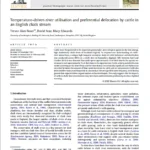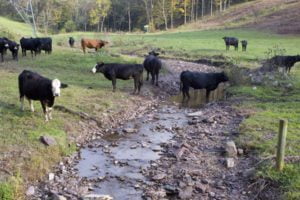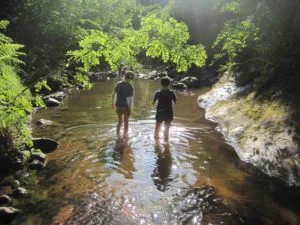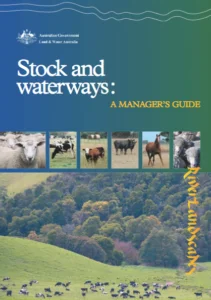Temperature driven pooing:
In a paper entitled ‘Temperature-driven river utilisation and preferential defecation by cattle in an English chalk stream‘ by Trevor Alan Bond, David Sear and Mary Edwards, it was found that that cattle standing in water ‘pooed’ five times more that the average defacation frequency. I suspect given how hot it gets here in Australia, those cows with access to streams spend even more time standing around in them than they do in England.
Cooler riparian areas:
Cattle favour riparian environments when it is warm because it is the place on farm that is coolest, whether in or out of the water. As temperatures rise, the research team found that cattle stand around more, pooing where they stand, with rates of pooing higher when in water.
It is possible for stock to get the benefit of cooling from the riparian zone, but from the other side of a fence. In the same way evaporative cooling works, we can plant shelter strips that enable cattle to stand near, but not in riparian areas, and still get the benefit of those cooler breezes coming off the water.
Journal Abstract and Link:
Cattle have the potential to be important geomorphic and ecological agents in the low-energy, high biodiversity chalk rivers of southern England. To improve our understanding of cattle–river interactions, a unique high temporal resolution study of cattle behaviour and distribution was conducted across 500 h on a chalk river in Hampshire, England (UK) between April and October 2010. It was observed that cattle spent approximately 2% of their time in the aquatic en-vironment and approximately 7% of their time in the riparian zone. Cattle activity and distribution varied according to the time of day and the time of year. A statistically significant correlation was recorded between the amount of time spent in-stream by cattle and air temperature. Cattle also defecated five times more frequently in-stream than the average defecation frequency, contributing greater than expected direct organic matter and nutrient inputs. The study suggests that the impacts of cattle in chalk river environments may have been underestimated, particularly at a time of global warming.
Cattle access and water quality:
I think this article will be really useful when talking to landowners about why we need cattle out of the river. Linking the impacts to people is often the best way to communicate the need to manage stock in riparian areas – for example, painting the picture of a family playing in the river totally unaware of cattle around the corner pooing in it, is a good way to get the message about how stock management impacts ‘flow’ downstream, with negative consequences for water quality and human health. There are also the associated issues of trampling, pugging and forming stock tracks that promote sediment loss, all caused when cattle cause when they have unlimited access to streams.
The number one way to improve riparian health – get stock out of the stream
- Cows in the river
- Enjoying the river
I have also put the link to our great ‘Managing Stock and Waterways guide’, which is full of practical tips and approaches to managing stock in (and out) of riparian areas, as well as links to more resources packed full of information about how to Manage Stock.
Banner Image: Wikimedia Commons, n.d., https://commons.wikimedia.org/wiki/File:Cows_in_the_Kara%C5%A1_River_near_Stra%C5%BEa_village,_Serbia_-_20090811.jpg
Publications
Fact Sheets
Fact Sheet 6 — Managing Stock
Fact Sheet 11 — Managing Phosphorus in Catchments
Fact Sheet 13 — Managing Riparian Widths
Riparian Land Management Technical Guidelines — Volume Two
Chapter G – Managing stock in the riparian zone
Principles for riparian lands management (2007)
Chapter 9 — Impacts of land management practices on riparian land
Management of riparian zones: Guidelines for community and landholder participation
Working with industry
High rainfall zone
Sheep/wheat zone
Managing creeks and waterways in the southern tablelands of New South Wales: a woolgrowers guide
Managing rivers and streams in Tasmania: a woolgrowers guide
Managing creeks and waterways in South Australia: a woolgrowers guide
Preventing creek erosion
Managing weeds in riparian areas
Insights: case studies on how farmers are successfully managing rivers, streams and creeks on wool properties
Are my waterways in good condition?
Powerpoint
This powerpoint presentation has notes to accompany each slide, explaining the key point being made and how you might explain it to others.
Download Power Point presentation (49.05 mb) or the PDF version (3.4 mb).




